When it gets cold, staying in the garage becomes uncomfortable for a person, and destructive for a car in terms of condensation and the development of corrosion. You need to choose the best way to make a warm garage with your own hands in accordance with its characteristics and your own financial capabilities.
Does the garage need heating
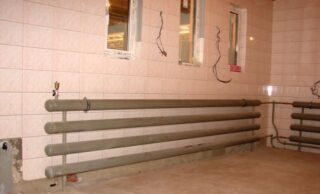
The opinion of drivers regarding the need to heat the garage is based on the following criteria:
- It is inconvenient and sometimes impossible to service a car in the cold.
- Deterioration in the quality of technical fluids. Blocking their circulation channels.
- The appearance of condensation, as a result - accelerated corrosion of the body, frame, equipment located in the room.
- Difficulty starting a cooled engine.
- Fast battery discharge.
In the cold, it is impossible to just sit alone or with friends, eat and drink coffee comfortably.
Overview of possible options
There are many ways to heat your garage, each with its own pros and cons.
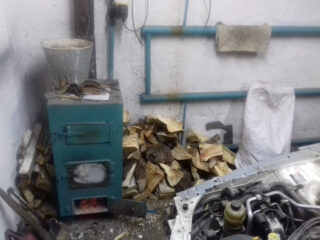
Garage heating options:
- Water. It can be central or autonomous. In the second case, antifreeze must be poured into the system in order to avoid its rupture when turned off. Permission is required to connect to public utilities. When self-installing, the water circuit is connected to its own boiler or equipment installed in a residential building.
- Electrical. Electric heating in the garage does not require approval, it is enough to have a meter and a junction box. The devices are distinguished by functionality, variety, variability of fastening, safety and high speed of warming up the room. Fan heaters, spiral and UV radiators, oil radiators give a good effect.
- Gas. It is too expensive to pull a separate branch to the garage, and you can put a cylinder and an economical burner, a convector or a heat gun in it without any problems. In order not to be left without heat, you should have a fully filled cylinder in reserve.
- Solid fuel. Firewood, coal, peat, briquettes burn with high heat transfer and it is not difficult to find such fuel. Also, there will be no problems with the purchase and installation of a modern long-burning stove. If you have the skills, you can make a potbelly stove.
- Air. Air is heated in the stove by convection when burning solid, liquid fuel and gas. Heating up in the chamber, hot air enters the pipes. After the cycle is completed, it returns to the boiler in a cooled state and the process repeats.
- Brick oven. This is a versatile structure that can be used for heating, cooking, smoking, curing meat, drying things. The object is capital, but effective, it can work on almost anything that burns.
After evaluating all available systems, the garage owner can only make the right choice and translate theory into practice.
Preparatory stage
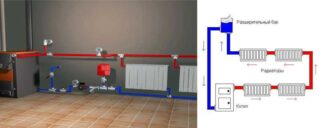
When planning to make heating in the garage with your own hands, you should focus on a number of criteria that affect the quality of the final result:
- type of building, attached or detached;
- the material from which the walls and floors are made;
- the size of the room;
- the cost of purchasing and installing equipment;
- availability and availability of fuel;
- required power;
- safety of the structure;
- the degree of autonomy of the device.
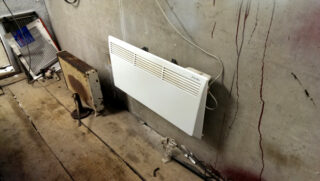
In addition, you need to objectively assess the pros and cons of different heating systems:
- Autonomous water does not require any maintenance and control, but it is expensive to install, it works only if there is current and a supply of fuel.
- Electricity allows you to get heat quickly, there is no need for intervention and refueling of devices. However, each volt-ampere is very expensive, plus powerful wiring is needed.
- A good gas boiler is easy to set up, economical, efficient and takes up little space. However, the price of the initial investment can be prohibitive.
- Solid fuel is inexpensive, efficient, but emits a lot of smoke. Arrangement of a high-quality chimney and storage space for fuel is required.
- Air heating is rarely used, but the boiler is expensive, and not everyone can afford it.
It makes sense to make a brick oven only in a large room. The product is multifunctional, capable of heating the entire garage, but requires a lot of costs in the construction and arrangement of a separate foundation.
After evaluating all the characteristics, it remains to draw up a diagram, purchase materials and carry out installation.
Installation features
Circuit heating system
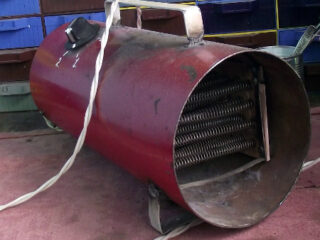
Considering that steel pipes are prone to corrosion, it is better to make the water circuit from reinforced plastic pipes. A special soldering iron and cutter are used for assembly. Fastening is carried out on clamps. The advantage of this design is that it does not collapse even when water freezes in it. From boilers, you can choose coal, gas and wood-burning models.
Air heating
This type of heating is used when it is necessary to keep heat throughout the entire volume of the room. For its organization, a system of air ducts with deflectors is made, where hot air gets from a heat gun or fan heater. The system allows you to create comfortable conditions in the building and quickly dry the air, eliminate condensation. The heating medium is fed through thin-walled steel pipes.
Gas heating
This method of heating a building provides for two approaches to execution. When connecting to the central highway, its owner is required only to have permits and considerable funds to pay for a permit, materials, equipment and services of specialists for its installation. This choice is advisable if you need round-the-clock heating of the garage.
A cylinder with a burner is placed when the room is used occasionally. The container with gas must be in the box; it is imperative to use special hoses, a reducer and a stable stand for the device.
Installing a wood-fired oven and working off
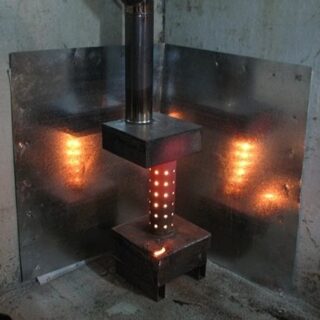
Such stoves are installed in the corners and ends of buildings next to the wall through which the chimney is passed. If the garage is wooden, a sheet metal screen is made. The same requirement applies to flooring. It is covered with a non-combustible material and turned away with a side. Working out emits a lot of thick soot, so it is better to install a coaxial or ceramic chimney, in such structures, carbon and soot practically do not accumulate.
Garage Heating Safety
Any heating system is an object of potential risk.
When heating a garage, the following safety measures must be observed:
- Monitor the ventilation so as not to get poisoned by combustion products.
- Do not keep fuel near a heating device.
- Prepare and place fire extinguishing agents in advance.
- Before starting the system, check the efficiency of the chimney and clean it regularly.
- Electrical wiring must be grounded.
- Do not place flammable objects near the appliances.
In all cases, it is recommended to install the simplest fire detectors in order to secure your own and neighboring property.








